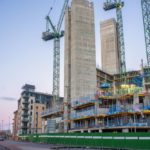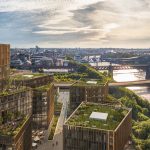Features - Design
Brownfield sites to solve the housing crisis
21 Nov 22

As half of local authorities in England did not build enough homes over the past decade to 2021, many people are forced into house shares and migration to major cities has been limited. Nathan Priestley – CEO of Priestley Construction, explains how renovating empty buildings on brownfield sites is key to solving the housing crisis.
The housing crisis in England is caused by a vicious cycle, with the lack of housing being the root issue. House building has not kept up with population growth in 150 out of 309 of the local authorities in England, as the 2021 Census and the Department for Levelling Up, Housing and Communities has revealed. Rishi Sunak’s reappointment of Michael Gove has been welcomed back by many, but there is still a lot of work to do to meet the increasing demand for homes and get more people on the property ladder. First, Gove must look to supporting the renovation of empty buildings as a solution.
Promoting a circular infrastructure
Renovation of empty buildings should be the top priority when it comes to delivering valuable housing, not least for the associated environmental qualities. Instead of using up greenfield sites to deliver new builds, we can give existing vacant buildings a new life, which doesn’t involve digging into new ground and significantly reduces reliance on new raw materials. In fact, as most of the materials used are recycled, less energy is used, providing significant ESG benefits. The reclamation and reuse of brownfield sites is a core component of the UK Sustainable Development Strategy because redeveloping a pre-existing building can greatly reduce carbon emissions.
Regeneration of run-down areas can also reduce crime by removing hotspots for vandalism, squatting and arson attacks. Brownfield redevelopment not only cleans up environmental health hazards, but it also acts as a catalyst for regeneration by removing eyesores to improve the visual aesthetic of an environment and boost the local economy by adding value. These benefits signify why the industry and Local Planning Authorities (LPA) must urgently prioritise investment in a circular infrastructure as a way of fixing the housing crisis.
Removing planning barriers
Renovating dormant buildings should be a quick process, supported wholeheartedly by LPAs. But planning officers all too often act as a barrier to renovation projects instead of approaching concerns with comprehensive feedback. From our experience, we have found that planning officers find reasons to reject, rather than approve planning permission, often overriding previously established timescales. In contrast, it seems they tend to be more lenient in approving plans on greenfield, simply because they don’t involve clearing areas leading to more safety regulations.
Although building on greenfield sites might provide a planning and developing process which is seen as more linier, it also eliminates valuable green areas and can have a devastating impact on wildlife and the countryside. At a time of climate crisis, our green spaces should be protected and therefore, brownfield sites should be the first point of call when creating housing.
Improving accessibility
The length of time it takes for the LPA to approve plans can have a big effect on viability, as the running costs for the building whilst it is still in planning continues which makes it unviable to sustain. Too often, we have experienced the disappointment of having to pull out of projects due to LPAs taking too long to give approval. This demonstrates clearly that there is not enough help given to developers to renovate and recycle old buildings. If the benefits of refurbishing old buildings were recognised, this would not happen as often. To make it worse, reasons for rejection from LPAs can be something as minor as the type of brick proposed to use in the development, which could easily be conditioned anyway. There should be no reason for LPA to reject a plan for the renovation of an old building unless it does not conform to policy or affects someone’s health. Therefore, I believe that the government need to enforce policies to make renovation projects more accessible for developers.
Creating beautiful spaces
My experience of renovating neglected buildings to create beautiful luxury homes in the form of apartments, flats and semi-detached houses, proves that it is more than possible to successfully utilise brownfield sites. Neglected listed mansions and dilapidated mills are just some of the sites that I have overseen the refurbishment of to create housing, a far better option than wasting the land. Transforming historic buildings whilst still retaining the original features can produce even more attractive homes, as they are full of character. While retaining history is important, I believe that the biggest benefit of this type of development is lessening the impact on the environment, and these are significant benefits that should be recognised by government and industry.
Regenerating our future
Before even considering building on greenfield sites, our industry must ensure we are not wasting valuable existing buildings that can be given new life first. As the Housing Secretary, Gove now needs to act and encourage the use of brownfield sites to create new housing so that the industry is influenced from the top-down. More recognition of the advantages in recycling buildings along with better communication and co-operation from the LPA are needed urgently to rectify the housing crisis.
If you would like to read more stories like this, then please click here
Related Articles
More Features
- Why early MEP design collaboration holds the key to smarter buildings
24 Jun 25
Working closely is essential to ensure that all aspects of a building’s design contribute to
- BSI publishes groundbreaking standard for MMC in residential developments
28 May 25
New specification to build confidence in modern methods of construction (MMC) for residential developments has
- Pagabo provides clarity on impacts of new NPPS and PPNs
12 Mar 25
The Labour government’s new National Procurement Policy Statement (NPPS) sets out strategic priorities for public
-
-
More Features
- Why early MEP design collaboration holds the key to smarter buildings
24 Jun 25
Working closely is essential to ensure that all aspects of a building’s design contribute to its overall energy performance.
- Solar on all new homes must align with 1.5 million homes target
20 Jun 25
The Government have said that solar panels will be included in the FHS, leading to installation on the vast majority of new build homes.
- Identify the source of moisture to protect your timber buildings
10 Jun 25
Timber rot, which occurs when moisture penetrates and remains in timber, is a common issue. While moisture-damaged timber buildings can be repaired, too often the
-
-
Most Read
- Heathrow cleared for take-off
- SMEs: building the future
- South East Construction Expo 2018 comes to Sussex
- Scottish construction collateral warranties: timeless, or on borrowed time?
- House Prices stable
- Canterbury Council invests in social housing
- Tougher requirements needed for company chiefs
- BAM Nuttall targets vibrating tools
- Construction and road interest groups seek solution to road congestion
- CITB launch skills analysis for Scottish construction
- National Winners revealed at NHBC Health and Safety Awards
- First UK spaceport to launch in Sutherland, Scotland
- Spotting the signs of modern slavery
- Working at Height safety breaches rise
- Mace: Modern methods of construction could create £40Bn export market






